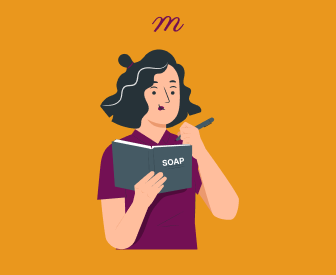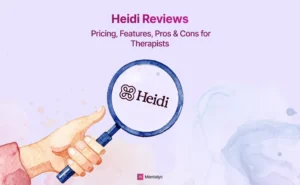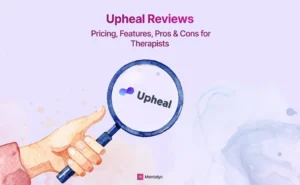You won’t believe the transformation your SOAP notes will undergo when you start working with kids! It’s time to take your pediatric SOAP notes to the next level. Get ready to learn how to make your notes to fit the needs of your little clients, including what to include, examples, templates, and expert tips. We’ll also explore pediatric documentation’s unique benefits and challenges and why it demands a specialized approach. Let’s explore pediatric documentation’s distinct benefits and challenges so you can improve your notes for little ones, regardless of your experience level.
What Are SOAP Notes and Why Use Them for Pediatric Clients?
When working with children, it’s essential to use SOAP notes. SOAP notes are a type of progress note used by mental health providers to document patient encounters. SOAP notes are valuable for tracking a child’s progress, communicating with other providers, and justifying medical necessity for insurance purposes.
The acronym stands for:
- Subjective – The client’s chief complaint and history in their own words
- Objective – Your observations and measurements
- Assessment – Your analysis and impressions
- Plan – Your plan for treatment, follow-up, and goals
For pediatric clients, SOAP notes offer a structured and consistent way to document developmental milestones, behavioral changes, responses to treatment, and more. This comprehensive record can help monitor growth and skills and assess the effectiveness of interventions.
Tools like Mentalyc can simplify documenting your sessions into structured SOAP notes. With automated, accurate, consistent documentation already drafted, you can focus more on observing and supporting the child, while still having the detailed record you need for collaboration and compliance.
Adapting SOAP Notes for Pediatric Behavioral Health
When documenting pediatric behavioral health care, it’s essential to adapt SOAP notes to the unique needs of young patients. This involves asking creative questions to understand their thoughts and feelings, observing behaviors and emotions, and considering developmental stages and family dynamics in assessments. Plans may also involve parental involvement or community resources.
Pediatric SOAP notes require modifications to accommodate the needs of child patients and their families. Here are the key adaptations:
- Shorter, more straightforward sentences and words. Sentence length should aim for 8-12 words to match a child’s attention span. Avoid complex medical terminology.
- More spacing and bullet points. Extra spacing between each section and bullet points within sections make the notes easier for children and caregivers to follow.
- Pictures and drawings. Illustrations and simple diagrams can supplement written notes, especially for younger patients.
- Focus on function, not just symptoms. Note how the child’s condition impacts their ability to function at school and home.
- Provide take-home summaries. Give families a brief overview of diagnoses, recommendations, and follow-up to assist with home care.
These adaptations help create functional, informative, and family-centered pediatric SOAP notes. They communicate your recommendations so that children and caregivers can easily understand and use them to improve the patient’s health and well-being.
When writing your pediatric SOAP notes, remember:
- Children are still developing and have different needs than adults, which should be reflected in your documentation.
- Children’s behaviors and symptoms may have different root causes than in adults, requiring different interventions and strategies. This should be evident in the documentation.
- Pediatric patients have caregivers involved in their treatment, so documentation must also consider the family’s needs.
The Benefits and Challenges of Pediatric SOAP Notes in Mental and Behavioral Health
The advantages of using pediatric SOAP notes are extensive. They help improve the quality of care by promoting a systematic and thoughtful approach. They also aid in better communication among healthcare providers. Detailed notes can also be crucial in addressing concerns about a child’s safety or progress. Moreover, pediatric SOAP notes enable early intervention, particularly important for children with developmental delays or learning differences. By promptly identifying issues and needs, healthcare professionals can collaborate with parents to provide the necessary support for children at a young age, leading to better outcomes.
However, documenting for pediatric clients does present some challenges. These include the need to keep notes concise yet comprehensive and to maintain client confidentiality. Concentrating on behaviors and conversations rather than personal interpretations and using the child’s words and objective observations is vital.
Children typically have shorter attention spans, and communicating with nonverbal or minimally verbal children requires creativity. In such cases, it’s essential to interpret behaviors and cues rather than relying on self-report. Building rapport with children also takes time, affecting the frequency of follow-up visits. Despite these challenges, the benefits of creating thorough, personalized pediatric SOAP notes far outweigh any difficulties.
Best Practices for Writing Effective Pediatric SOAP Notes
Adhering to these best practices will make your pediatric SOAP notes a more effective tool for assessment and treatment.
Emphasize Behavior and Development in SOAP Notes
Carefully observe the child’s behavior, moods, social abilities, interests, personality, and development. Note any delays or difficulties and track their progress. Give specific examples of the child’s social interactions and skills compared to typical development at that age. This information will help inform future treatment plans.
Include Information from Caregivers and Teachers in Pediatric SOAP Documentation
When documenting a child’s progress, ask open-ended questions to obtain perspectives from the child’s parents, guardians, teachers, and other caregivers. Inquire about their observations of the child’s symptoms, progress, challenges, strengths, environment, support systems, and needs. Also, ask them to voice any specific concerns. Note their insights in your SOAP notes to understand the child’s functioning comprehensively. This context will help you provide appropriate treatment.
Discuss Treatment Approach and Response
Describe your therapeutic approach with the child, including how you use play, workbooks, and conversations to engage them. Discuss the child’s responses and progress in treatment, noting any difficulties or resistance encountered and how your methods help them develop skills and overcome challenges.
Focus on Strengths
Rather than focusing solely on a child’s problems and symptoms, which can dishearten families, note their strengths, talents, interests, and sources of joy. Identify protective factors in their lives, such as supportive friends, activities they excel in, and caring adults. Building on these strengths provides growth opportunities.
Recommend Practical Strategies
To empower and encourage families, offer practical advice on helping children, such as allowing extra response time, establishing routines, presenting choices, and rewarding good behavior. Specific, actionable strategies make families feel more capable and hopeful.
Provide a Safe Space
Take a compassionate, understanding approach so the child and family feel your office is a secure environment where they are listened to, valued, and cared for. Foster trust by showing empathy, encouraging, and focusing on their strengths. This will make children and caregivers more open to sharing freely and engaging actively in therapy.
Set Achievable Goals in Pediatric SOAP Notes
When setting goals for a child, aim for ones that are realistic yet challenging for their age, and break down any larger goals into smaller, measurable steps.
Review Pediatric SOAP Notes Regularly.
Review your notes periodically to monitor progress and watch for warning signs, ensuring your documentation remains up-to-date and effective.
Ensure your pediatric SOAP notes are clear, comprehensive, and efficient with the latest documentation practices. Explore tools that simplify note-taking for pediatric care and keep your records organized and thorough.
That’s where Mentalyc helps—by automatically transforming session conversations into structured SOAP notes that are clear, comprehensive, and insurance-ready. With documentation handled, you can focus more on engaging the child and collaborating with parents or teachers, while still maintaining accurate, up-to-date records.
Template for Pediatric SOAP Notes
The following template covers the core areas to address for each section of the SOAP note while allowing flexibility for each pediatric patient’s unique needs, developmental level, and concerns. Using this framework can help ensure consistent and complete documentation of mental health concerns in children and adolescents.
SOAP notes for pediatric patients with mental and behavioral health concerns will include the following sections:
Subjective (S)
- A chief complaint or reason for visit, reported by the child or caregiver
- Pertinent developmental, medical, family, and social histories
- Symptoms and concerns, using child’s words when possible
Objective (O)
Provide factual observations of the client’s:
- Appearance and behavior
- Speech and language skills
- Mood and affect
- Thought processes
- Perception, cognition, and memory
- Relevant physical exam findings
Assessment (A)
- DSM (or ICD) diagnoses in order of importance
- Any relevant differential diagnoses
Plan (P)
- Medication changes
- Therapy or behavioral recommendations tailored to the child’s age and needs
- Safety planning as needed
- Follow-up instructions and timing
Examples of Pediatric SOAP Notes for Common Clinical Situations
These examples show how a clinician would document common issues in children and teens: generalized anxiety, separation anxiety, depression, and ADHD. Following the standard SOAP format, the notes use age-appropriate language, suggest initial evaluations and referrals, and outline the next steps. Keeping detailed records of your work with young clients enables the best care and continuity if other providers are involved.
Generalized Anxiety in an 8-year-old
S: B.T. reports feeling “worried all the time” and having trouble sleeping. His mother says he seems anxious and has frequent stomachaches.
O: B.T. presented as tense but cooperative. He reported worries about school, friends, and family health. His speech was rapid, and eye contact was fleeting. Billy said his stomach “hurts a lot.”
A: Generalized Anxiety Disorder, Adjustment Disorder with Anxiety
P: Recommended coping strategies like deep breathing, limiting screen time before bed, and journaling worries. Referred to a child psychologist for assessment and potential therapy. Follow-up in two weeks.
Separation Anxiety in a 7-year-old
S: L.Q. is a 7-year-old girl who has had difficulty separating from her parents, especially her mother, in the past few months. Her mother reports that L.Q cries and clings whenever she tries to leave for school or other activities.
O: L.Q was shy but cooperative during the interview. She became tearful when discussing being separated from her mother and reported frequent worries that something bad would happen if her mother were not with her.
A: Separation Anxiety Disorder
P: Recommended gradual exposure exercises for L.Q and her mother to practice separating for short periods. Referred L.Q to a child psychologist for cognitive behavioral therapy to address her anxiety. Provided a handout on separation anxiety for parents. Follow-up in four weeks to monitor progress and adherence to treatment plan.
Depression in a 15-year-old
S: M.C.’s parents have brought him in due to changes in behavior and mood over the past three months. They report that M.C. has lost interest in activities, sleeps excessively, and gained weight. His grades have declined significantly.
O: During the interview, M.C. appeared lethargic and discouraged. He reported a lack of motivation, sadness, hopelessness, and poor concentration. He has also withdrawn from friends and hobbies.
A: Major Depressive Disorder
P: Recommended monitoring of mood, sleep, and appetite. Referred M.C. to a psychiatrist for medication evaluation and a psychologist for cognitive behavioral therapy. Provided handout on depression management strategies for adolescents—follow-up in two weeks to discuss a treatment plan and monitor for suicidal thoughts.
ADHD in a 12-year-old
S: J.P. was brought in by her parents due to problems focusing in school and at home. Teachers report that J.P. is distractible, impulsive, and struggles to finish tasks.
O: J.P. was talkative and energetic. She had trouble sitting still during the interview and was easily distracted by noises outside the office. She reported difficulty paying attention in class and frequent interruptions.
A: Predominantly Inattentive Presentation of ADHD.
P: Recommended parent/teacher-completed behavior rating scales. Referred to a psychiatrist to consider medication for symptoms and a counselor for behavioral strategies. Scheduled a follow-up in three to four weeks to review recommendations and next steps.
Pro Tip: If you’re looking to enhance your pediatric SOAP notes with precision and ease. Mentalyc’s platform offers automated tracking, structured templates, and streamlined workflows, helping you achieve better documentation, improved outcomes, and more time for patient care
Conclusion: Mastering Pediatric SOAP Notes for Child and Adolescent Care
You now have an overview of pediatric SOAP notes and how to adapt them for children and teens. Preparing and approaching SOAP note writing with intentionality is essential to ensure a clear and comprehensive clinical picture. Mastering SOAP notes takes practice, but having SOAP notes templates and examples can assist clinicians in this process. When documenting pediatric behavioral health concerns, it is crucial to consider their unique considerations. Remember that perfecting SOAP notes may require practice, but the benefits for children are worth the effort. Start with a basic template and then personalize it to meet your requirements. Additionally, you can request to view examples from colleagues and seek feedback from a supervisor to refine your notes. With regular use, documenting pediatric SOAP notes will become second nature; we believe in you!
Sign up for Mentalyc today, a HIPPA-compliant AI notes software designed to assist you in generating your SOAP notes, increase efficiency, and automate your notes with additional templates so you can spend more time doing what you love—helping kids!
FAQs About Pediatric SOAP Notes for Mental and Behavioral Health
How detailed do pediatric SOAP notes need to be?
SOAP notes for children and teens should provide a high-level overview of the session rather than an exhaustive account of everything discussed. Focus on the key highlights, events, and takeaways. Be concise yet capture the essential details another clinician would need to get up to speed on the client’s care. Provide enough context around discussions and the client’s mental/emotional state, but avoid verbatim transcripts.
Should parents or guardians review and sign the SOAP notes?
Whether parents should review and sign a child’s SOAP notes depends on the child’s age, the clinician’s discretion, and local laws. For young children who are not yet able to consent to treatment themselves, it is typically required for parents to review and sign the notes. However, for teenagers who are mature enough to consent to treatment confidentially, some clinicians may share general overviews of sessions and treatment progress with parents while keeping specific details private. Other clinicians may assess whether the teen can consent to treatment autonomously. Nevertheless, clinicians must always follow their state laws regarding confidentiality and informed consent for minors.
Should goals and treatment plans be designed for each child’s age?
Yes, the treatment goals and plans in SOAP notes should always be designed specifically to the child’s unique needs, issues, and stages of development. Goals and interventions appropriate for a teenager will differ significantly from those for a young child. An individualized approach is essential for effective pediatric behavioral health treatment.
At what age do children’s SOAP notes no longer require parental consent?
The age at which parental consent is no longer required for children’s mental health SOAP notes varies by state and clinician discretion. Generally, once a child reaches the age of maturity defined by law in their state (around age 14 to 17), parental consent may no longer be legally required. However, clinicians should consider the child’s cognitive and emotional development to determine the capacity for autonomous consent.
Should I write SOAP notes for each problem or diagnosis?
The level of documentation required depends on the case’s complexity and the client’s needs. For clients with multiple diagnoses or issues, separate SOAP notes can be written for each problem or diagnosis. This approach ensures that each condition receives the necessary attention and documentation. However, a single comprehensive SOAP note may suffice for more straightforward cases with only one or two main issues. The important thing is to document all critical details to support the client’s treatment.
How often should I update my pediatric client’s SOAP notes?
Updating your client’s SOAP notes after every session or critical interaction is best. This will ensure that the notes accurately reflect your client’s mental health status, treatment progress, and changes over time. For ongoing clients, reviewing the previous SOAP notes before each session can also help guide the discussion and remind you of important details. Writing a new SOAP note after each session is ideal for clients you see weekly or bi-weekly.
What should I include in the subjective section for kids?
The subjective section of a pediatric SOAP note should include observations about the client’s mood, behavior, sleep, and appetite. It’s important to note any changes in functioning at home or school. Summarize any concerns the parents mention regarding their child. You can also include quotes from the client or their caregivers that provide insight into their mental state. The goal is to capture a holistic picture of how the client is doing from a subjective perspective.
Disclaimer
All examples of mental health documentation are fictional and for informational purposes only.
Why other mental health professionals love Mentalyc

“It takes me less than 5 minutes to complete notes … it’s a huge time saver, a huge stress reliever.”
Licensed Marriage and Family Therapist

“A lot of my clients love the functionality where I can send them a summary of what we addressed during the session, and they find it very helpful and enlightening.”
Therapist

“By the end of the day, usually by the end of the session, I have my documentation done. I have a thorough, comprehensive note … It’s just saving me hours every week.”
CDCII

“Having Mentalyc take away some of the work from me has allowed me to be more present when I’m in session with clients … it took a lot of pressure off.”
LPC







